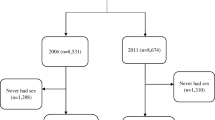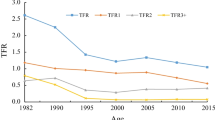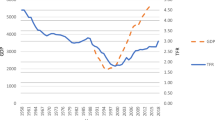Abstract
In the present study, the technique of life table analysis is used to examine fertility change by birth order in rural China, particularly in the rural portion of Anhui province. The study mainly focuses on the relationship between fertility change by birth order and planned socioeconomic changes. Change in fertility by birth order in the last few decades in rural China and Anhui is used as an indicator of the effects of planned socioeconomic changes on the process of family building. Some light is shed on the extent to which fertility changes affected women at different stages of their reproductive career. The data are from the 1/1000 Fertility Survey of China, conducted by the Family Planning Commission in 1982.
Similar content being viewed by others
References
Aird, John. (1972). ‘Population policy and demographic prospects in the People's Republic of China’ in People's Republic of China: An economic assessment, compendium of papers submitted to the joint economic committee, Congress of the U.S. pp. 220–331. Washington, D.C.: US Government Printing Office.
Aird, John. (1982). ‘Population studies and population policy in China,’ Population and Development Review 8: 267–297.
Aird, John. (1985). ‘Coercion in family planning: Causes, methods, and consequences,’ Congressional Record-Senate, 7 June: S7776–7788.
Anhui Statistical Bureau (1988). Anhui Tongji Nianjian (Statistical Year-Book of Anhui). Hefei: People's Publishing House of Anhui.
Bongaarts, J. and Susan Greenhalgh (1985). ‘An alternative to the one-child policy in China,’ Population and Development Review 11: 585–618.
Bongaarts, J. and R.G. Potter (1983). Fertility, Biology and Behaviour: An Analysis of the Proximate Determinants. New York: Academic Press.
Chen Pi-chao and Adrienne Kols (1982). ‘Population and birth planning in the People's Republic of China,’ Population Reports 10, no 1: J577-J618.
Chen, Shengli (1984). ‘Fertility of women during the 42 years period from 1940 to 1981,’ in Analysis on China's National One-per thousand Population Sampling Survey. pp. 32–58. Beijing: China Population Information Centre.
Chen, Wei (1989). ‘Wuoguo shengyulu de chuyao zhijie juedin yinsu fenxi (An analysis of major proximate determinants of fertility),’ Renkou Yanjiu (Population Reserach) (in Chinese). 1: 16–22.
China Population Information Centre (1984). Analysis on China's National One-per-thousand-population Fertility Sampling Survey. Beijing: China Population Information Centre.
Coale, A.J. (1984). Rapid Population Change in China, 1952–1982. Committee on Population and Demography Report No 27. Washington D.C.: National Academy Press.
Coale, A.J. and S.L. Chen (1987). Basic Data on Fertility in the Provinces of China, 1940–1980. Papers of the East-West Population Institute, 104. Honolulu: East-West Center.
Coale, A.J., Li Shaomin and Han Jingqing (1988). The distribution of interbirth intervals in rural China, 1940s to 1970s. Papers of the East-West Population Institute, 109. Honolulu: East-West Center.
Croll, Elisabeth, Delia Davin and Penny Kane (198). China's One-Child Family Policy. New York: St. Martin's Press.
Feeney, Griffith (1985). ‘Parity progression projection,’ International Population Conference, Florence 1985, International Union for the Scientific Study of Population, Vol. 4, Pp: 127–129.
Feeney, Griffith and Yu Jingyuan (1987). ‘Period parity progression measures of fertility in China,’ Population Studies 41: 77–102.
Greenhalgh, Susan (1989). States and societies: political aspects of population policy and family planning in developing countries, with special reference to China. Paper pres. at IUSSP Seminar on the Role of Family Planning Programs as a Fertility Determinant, 26–30 June 1989, Tunis.
Gu, Shenzu (1986). ‘Zhongjian shengyulu bianliang due funu shengyulu de yingxiang (The effects of proximate determinants on women's fertility) (in Chinese),’ Renkou Dongtai (Population Dynamics). 5, 1986 (Special issue).
Hobcraft, J.N. and G. Rodriguez (1980). Methodological issues in life table analysis of birth histories. Paper presented at a Seminar on the Analysis of Maternity Histories, Sponsored by the IUSSP, the CPS (London School of Hygiene) and WFS, London.
Jiang Zhenghua (1986). ‘Shehui jingji yinsu due Zhongguo shengyulu de yingxiang (The effect of socioeconomic factors on China's fertility)’ Renkou Yanjiu (Population Research). 3: 25–30.
Kane, Penny (1987). The second billion: population and family planning in China. Penguin Books.
Lavely, William. R (1986). ‘Age patterns of Chinese marital fertility, 1950–1981,’ Demography 23: 419–434.
Lin, Fude (1986). ‘Zhongguo shengyulu zuanbian de tedian (The characteristics of fertility transition in China) (in Chinese),’ Renkou Yanjiu (Population Research) 4: 2–7.
Mao, Zedong (1938). Zhongguo gongchandang zai minzu zhanzhen zhong de diwei (The role of Communist Party in the national war). Selected Works of Mao Zedong, Vol. 2. Beijing: People's Publishing House.
Mauldin, W.P. (1982). ‘The determinants of fertility decline in developing countries: An overview of available empirical evidence,’ International Family Planning Perspectives 8: 119–127.
Mosher, Steven W. (1983). Broken Earth: The Rural Chinese. New York: The Free Press.
Parish, William, L. and Martin. K. Whyte (1978). Village and Family in Contemporary China. Chicago: University of Chicago Press.
Pasternak, B. (1986). Marriage and fertility in Tianjin, China: fifty years of transition. Paper of the East-West Population Institute, 99. Honolulu: East-West Center.
Poston, Dudley L. Jr and Baochang, Gu (1987). ‘Socioeconomic development, family planning, and fertility in China,’ Demography 24: 531–550.
Rodriguez, G. and J.N. Hobcraft (1980). Illustrative analysis: life table analysis of birth intervals in Colombia. WFS Scientific Reports 16.
Rodriguez, G. and J. Menken (1984). Birth history analysis (BIRTHS), In Software User's Manual, WFS Basic Document, 12. pp. 235–250. London: World Fertility Survey.
Ryder, N.B. (1980). ‘Components of temporal variations in American fertility,’ In R.W. Hiorns (ed), Demographic Patterns in Developed Societies. (Symposia of the Society for the Study of Human Biology. 19). London: Taylor and Francis.
Smith, D. (1980). Life table analysis. WFS Technical Bulletins 6.
Srinivasan, K. (1980). Birth intervals analysis in fertility surveys. WFS Scientific Reports 7.
Tien, H. Yuan (1983). ‘Age at marriage in the PRC,’ China Quarterly. 93: 90–107.
Tien, H. Yuan (1984). ‘Induced fertility transition: impact of planning and socioeconomic change in the People's Republic of China,’ Population Studies 38: 385–400.
Wang, Feng (1988). ‘The roles of individual's socioeconomic characteristics and the government family planning program in China's fertility decline,’ Population Research and Policy Review 7: 255–276.
Wang, Jichuan (1989). ‘Determinants of fertililty increase in Sichuan, 1981–86,’ Population and Development Review 14: 481–488.
Wang, S.X, Y de, Chen, Charles, H.C. Chen, Roger, W. Rochat, L.P. Chow and R.V. Rider (1987). ‘Proximate determinants of fertility and policy implications in Beijing,’ Studies in Family Planning 4: 222–228.
Wolf, Arthur. P. (1986). ‘The pre-eminent role of government intervention in China's family revolution’, Population and Development Review 12: 101–116.
Wu Cangping (1986). ‘Zhongguo shengyulu xunsu xiajiang de limn jieshi (Theoretical explanation on rapid decline of China's fertility) (in Chinese),’ Renkou Yanjiu (Population Research). 6: 10–16.
Yang, Quanhe (1987). ‘Fertility and some determinants of fertility decline in Huaibei Plain, Anhui province, China, 1982,’ Journal of Biosocial Science 19: 323–344.
Yang, Quanhe (1990). ‘Age at first marriage and fertility: the case of rural Anhui,’ Journal of Biosocial Science 22: 143–157.
Yang, Quanhe (1990). Planned fertility decline in rural China: the case of Anhui province. Unpublished Ph.D. thesis. The Australian National University.
Zou, Ping (1987). ‘Mechanical impact of Chinese family planning policy on parity ratios,’ Population Science of China. 3: 29–35.
Author information
Authors and Affiliations
Rights and permissions
About this article
Cite this article
Yang, Q. Fertility change in rural China, 1949–1982. Popul Res Policy Rev 10, 157–182 (1991). https://doi.org/10.1007/BF00128819
Issue Date:
DOI: https://doi.org/10.1007/BF00128819




